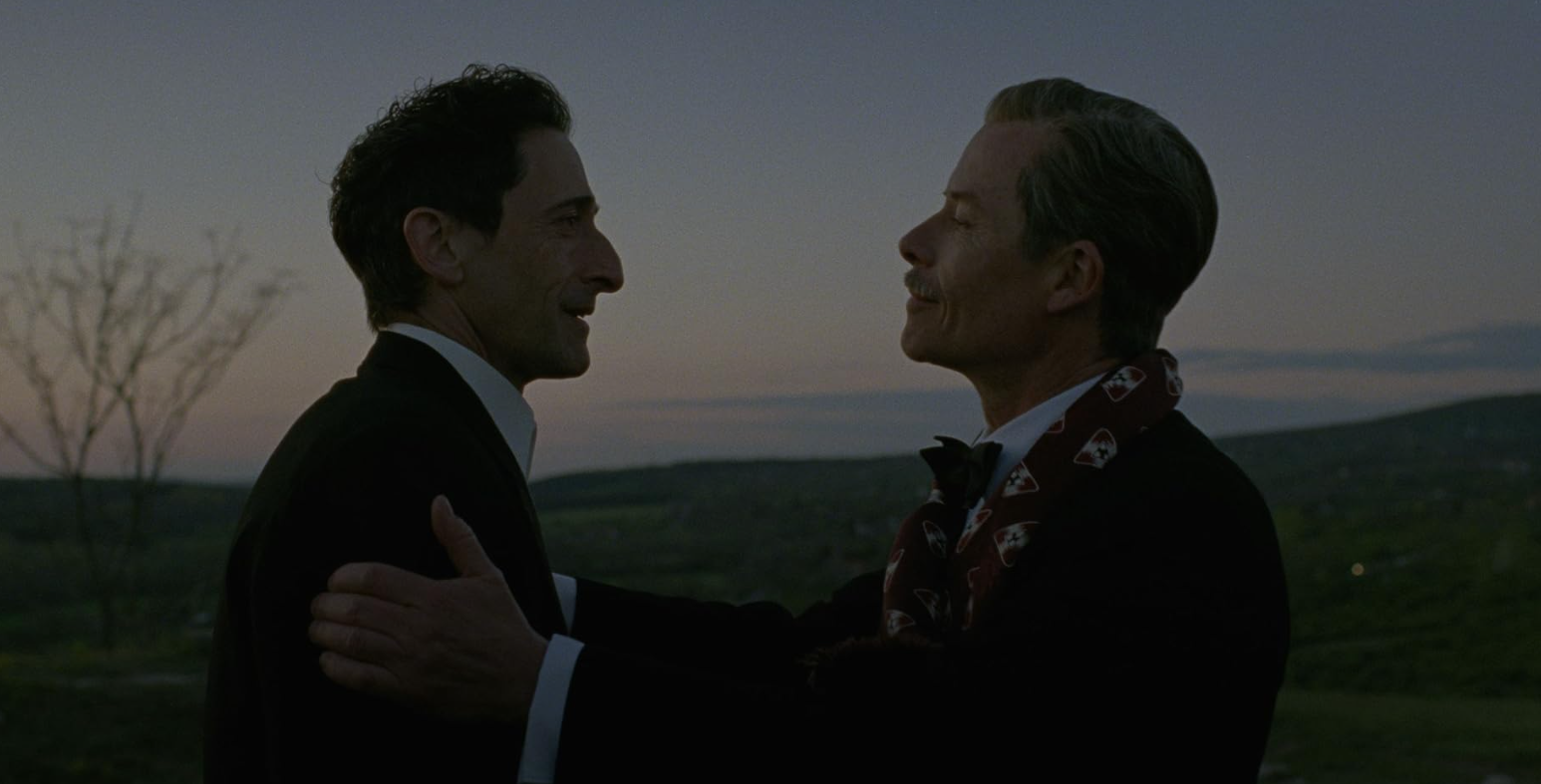The Brutalist (2024)


SHOULD I SEE IT?
YES
The Brutalist is an absolute awards contender you should see on as big a screen as possible. And yes, it is 3 hours and 35 minutes long (with a 15-minute intermission) and was made for less than $10 million. Remember that as you watch it.
There are great performances in the film, but Adrien Brody is as unforgettable as Guy Pearce is as diabolical. Felicity Jones has arguably never been better.
The craftsmanship is stellar, with remarkable production and set design, breathtaking cinematography, and a score that feels like they come together to create one massive character in and of itself.
NO
There are those who call the film a masterpiece. And there are those who find it pretentious, joyless, and overlong. The Brutalist is a divisive work, with a very long run time, though it does give audiences a whole lot of things to ponder and consider. Not an easy watch.
The film frequently uses suffering as a leverage point for much of what occurs to its characters. That can be taxing to endure for an audience already itchy at the prospects of 215 minutes.
Ultimately, the second half of The Brutalist leaves the film embracing the very conventions it pushes away in the opening half and becomes quite melodramatic and on-the-nose.
OUR REVIEW
The Brutalist is expansive. The story, 215 minutes long, is a throwback to the extended cinematic epics from long ago in the formative days of the movie industry. We even get to experience a 15-minute intermission.
Directed by Brady Corbet (Vox Lux), and co-written with Mona Fastvold, The Brutalist is big in nearly every way, with one major exception: The budget. Shot for less than $10 million, you would think this movie would have to be one of the most expensive films produced all year. There’s an epic nature to all of this. And it plays big.
Big in scope and design, big in performance, big in the span of time the film covers and big in the bold personalities who populate the story of a Hungarian-Jewish immigrant who arrives in New York City, c. 1947, just after the end of World War II. A Holocaust survivor, László Tóth, played masterfully by Adrien Brody, experiences what Corbet calls “The Enigma of Arrival,” participating in a tearful reunion with his cousin Attila (Alessandro Nivola) at a train station. Once settled in Pennsylvania, László soon secures a job in Attila’s furniture store as he tries to build a life for the family he hopes to bring to America.
There have certainly been many movies that explore the story of an immigrant coming to America to pursue the American Dream. However, Corbet spares no blemishes with how we view László. Imperfect and impulsive decisions are shown to us almost immediately as he arrives in America. However, he is also presented as someone simply overcome and overwhelmed with everything in front of him. In key moments, this is where Daniel Blumberg’s fantastic score reaps great benefits for us as viewers. He underscores the emotional swings László is feeling and experiencing, while also guiding us through a story that will take many twists and turns along the way.
Brody is completely dialed into this performance and he takes an intriguing screenplay and elevates the material tenfold. A gifted and talented architect, László hunts and pecks his way into attempting to utilize and showcase his skills. This places him in the crosshairs of the Van Buren family - first by introduction to son Harry (Joe Alwyn), and later to his father, Harrison Lee Van Buren (played by a sinister Guy Pearce).
Wealthy and rather eccentric, Harrison’s manic behavior leads to the eventual hiring of László to work on a monumental community center project. At its core, Harrison wants to create a place of gathering and community to honor his recently deceased mother. However, he seduces László into a world of wealth and extravagance, creating obstacles and distractions that not only slow down the development of the project but also tap into weakness and vulnerability that László would be best served to leave behind.
Over the course of the film László experiences, or believes he is the victim of, betrayal and distrust. There are unspeakable violations that occur and tender moments which turn uncomfortably rough. Kindness can often fall away and become something tactical and menacing. Corbet tiptoes on the precipice of making a film that is far more bleak and dead inside than we realize; emblematic perhaps of the giant stone structures and massive pours of concrete that László relies on as a means of both his need to create and his need to survive.
Brody’s portrayal of László is that of a man teetering on the edge of either breaking down or breaking through. However, make no mistake, Corbet is not swimming in the notion that America is the land of the free and home of the brave. President Reagan once said, “You can go live in France, but you will not be a Frenchman. But … anyone, from any corner of the world, can come live in the United States and become an American.” László never seems to find that acceptance, even when Harrison agrees to bring his family from Europe to America, reuniting László with his wife Erzsébet (Felicity Jones) and niece Zsófia (Raffey Cassidy).

Wheelchair bound, Erzsébet’s arrival glimmers with both promise and disappointment and Zsófia, youthful and innocent, has not only become her aunt’s de facto caretaker but also is mute. The family’s reunion in America, now in 1953, is largely used to launch the film’s post-intermission second act - “The Hard Core of Beauty.”
Following a legitimate 15-minute intermission, the film unfortunately takes a significant step backward. More conventional in story and scene structure, the film starts to spoon-feed us dialogue and present scenes that feel heavy-handed and less engaging. The movie no longer pulses with urgency and curiosity, it grinds itself to the nub. This “Hard Core of Beauty” Corbet preps us for in Act Two, becomes a plodding journey of argument, anger, bombast, and spectacle.
And that presents one of many conundrums within The Brutalist. The first half is tremendous. We become immersed not in a snapshot of an America we have grown accustomed to, but an America as seen through the eyes of László. Corbet and Fastvold have crafted their screenplay to place in an increasingly uneasy world of interpersonal exchanges that seem less than genuine.
Ultimately, in the second half, everything just becomes too easy.
Keeping things afloat however are a number of unbelievable images captured by cinematographer Lol Crawley. The upside down Statue of Liberty shot, which opens the film and is shown on one of the film’s posters, is already etched into the minds of many as one of the 2024’s most striking visuals. Judy Becker’s work as production designer is incredible. The film’s structures, the angles and design choices and showcasing of brutalist architecture creates an almost invisible character that looms over and haunts László’s every decision.
As you can imagine, with the film’s wide expansion nationwide in the throes of awards season, there is nothing quite like this playing at the nearby multiplex. Shot in VistaVision, a 1950s film format created by Paramount Pictures that arguably became a precursor to the arrival of IMAX years later, Corbet’s vision for his film proves almost limitless. But along the way, he struggles to find a consistent message.
As I think about The Brutalist and talk about the film, I continue to come back to one main thought that perhaps speaks to how the film impacted me the most.
Is it the weight of our world that crushes us, or the burdens we carry in trying to create our legacy?
CAST & CREW
Starring: Adrien Brody, Felicity Jones, Guy Pearce, Raffey Cassidy, Joe Alwyn, Stacy Martin, Emma Laird, Alessandro Nivola, Isaach de Bankolé, Michael Epp, Jonathan Hyde, Peter Polycarpou, Maria Sand, Salvatore Sansone
Director: Brady Corbet
Written by: Brady Corbet, Mona Fastvold
Release Date: December 20, 2024
A24
